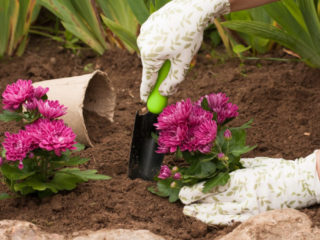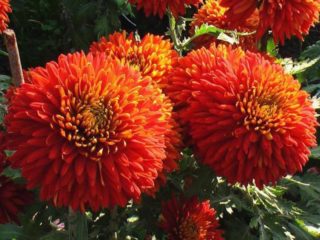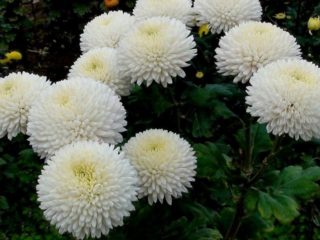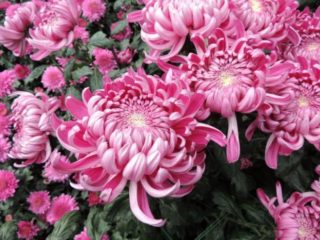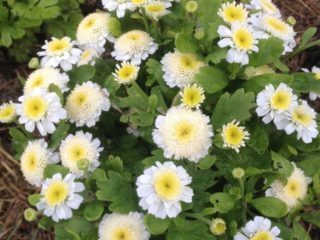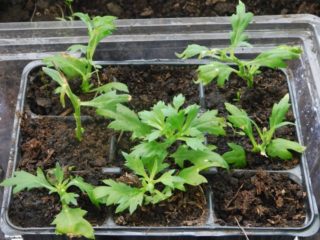Content
Diseases of chrysanthemums need to be known from photographs in order to recognize ailments on flowers in time. Most diseases are treatable, provided that it is started not too late.
Symptoms of diseases and pests in chrysanthemums
Chrysanthemums are affected by a variety of fungal diseases and pests. At the same time, the signs of ailments are in many ways similar. If alarming symptoms appear on the shoots, leaves and flowers of the plant, then for the gardener this should be a reason for a careful examination of the chrysanthemum.
You can understand that a plant has been exposed to pests or fungi by the following signs:
- yellowing and wilting - almost any disease leads to the fact that the foliage of the plant ceases to receive nutrition and dries up;
- the appearance of dark dots and spots, sometimes chrysanthemum leaves are covered with spots due to disturbed vegetation, sometimes the dots are fungal spores or pest larvae;
- curling and dying off of foliage in the lower part of the plant, this often happens with root rot or nematode infection;
- the appearance of an unusual plaque on the leaves and stems of a plant, for example, a spider mite leaves a light cobweb on the back of the leaf plates;
- deformation of buds and lack of flowering, this often happens when infested with meadow bugs.
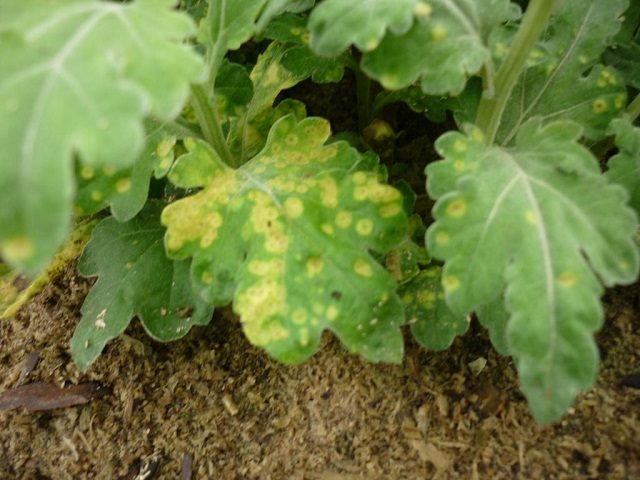
For any diseases, spots appear on the leaves of the plant.
When the first alarming symptoms occur, it is necessary to examine the plants and establish which disease they suffered from.
Chrysanthemum diseases and their treatment
There are several main ailments that affect chrysanthemums most often. These are mainly fungal diseases, but sometimes the flowers succumb to the effects of viruses.
Septoria
The symptoms of the disease are spots on the foliage of a flowering perennial. At first they are yellow, then gradually acquire a dark brown and black hue, grow and merge with each other. The disease spreads from the bottom up, first the root leaves of the plant suffer. If you do not start treating septoria, then it can lead to the complete death of a perennial.
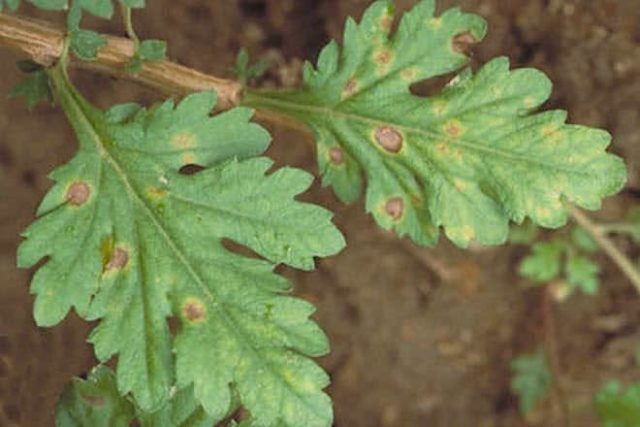
Septoria can be recognized by yellow-brown spots
Getting rid of septoria in the early stages is quite simple. It is necessary to completely remove the affected leaves, and then treat the plant with Bordeaux liquid or copper preparations - vitriol, HOM solution.
White rust
Fungal disease has characteristic symptoms. First, lighter areas appear on the leaves, and orange spots of a mealy structure appear on the underside of the leaf plates. Over time, the disease spreads through the flower, the chrysanthemum weakens and begins to fade. Such a plant can no longer bloom properly.
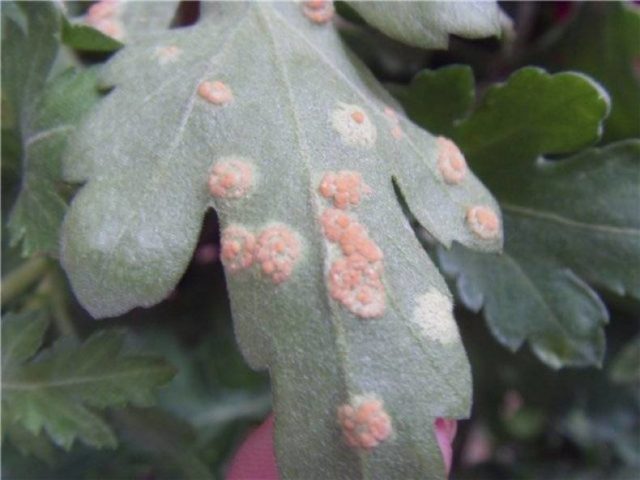
White rust appears with mealy orange spots on the bottom and light areas on the top of the leaf.
To cure rust, you need to urgently cut off all leaves with light and orange spots.After that, you need to thin out the chrysanthemum bushes to ensure free air access, and spray the flower bed with Bordeaux liquid or copper sulfate. Subsequently, chrysanthemums need to be watered very carefully so that water does not fall on their leaves.
Fusarium
A fungal disease affects the root system. But the first symptoms become noticeable on the leaves, they turn yellow and turn brown, begin to dry out and fall off. The nutrition of the plant is disrupted, the chrysanthemum ceases to receive nutrients from the soil in the required volumes and ultimately dies.

With fusarium, the leaves become covered with dots and turn yellow
To cure the disease, you need to remove the affected leaves and flowers. Planting chrysanthemums is sprayed with Bordeaux liquid, and the soil is spilled with solutions that increase acidity. for example, potassium sulfate or ammonium nitrate. Individual plants that have suffered too much from the disease are best eliminated, it is almost impossible to save a seriously affected root system.
Powdery mildew
The fungus very often infects chrysanthemums in damp and warm weather. The disease manifests itself with a recognizable bloom on the leaves, whitish, ash-gray, with a mealy structure. As the disease progresses, the leaf plates begin to wither and die off, the plant stops vegetative processes, and it dies.
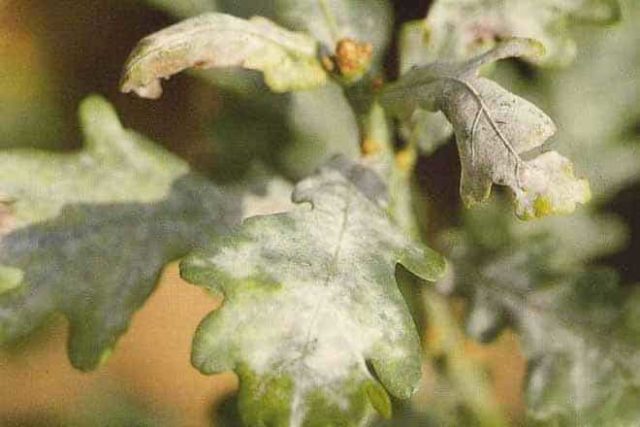
Powdery mildew leaves a whitish-gray coating on foliage
You can cope with powdery mildew with standard fungicides - copper sulfate, HOM solution, Fundazol helps well. Before you spray the flower bed, you must first remove the affected leaves from the chrysanthemums, and also completely eliminate the heavily affected plants.
Bacterial root cancer
The disease belongs to the category of incurable, although it does not affect chrysanthemums very often. The most striking symptom of bacterial cancer is the growths on the stems of the plant. Cancer develops rapidly, chrysanthemum not only stops blooming, but also completely dies.
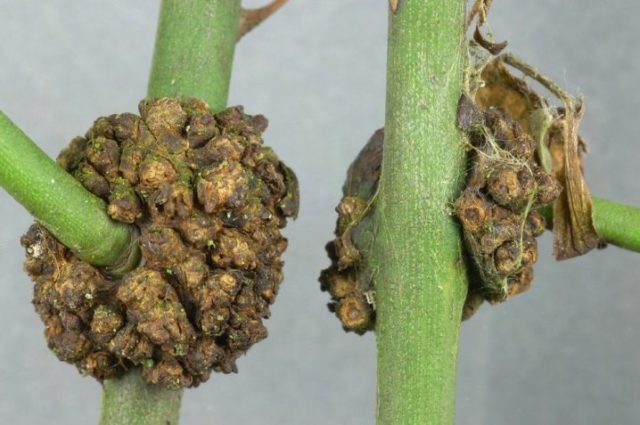
Bacterial cancer manifests itself as growths on the stems
When alarming signs appear, the diseased chrysanthemum must be removed from the flower bed entirely, it is impossible to save it. The plant affected by the disease is burned, and the soil in which it grew is treated with a formalin solution. You cannot plant other plants in this area for at least a month.
Chrysanthemum mosaic
One of the most dangerous diseases for chrysanthemum is the viral mosaic. It is quite easy to recognize it - uneven spots of a light shade appear on the leaves of an infected plant. The chrysanthemum begins to grow more slowly, its flowers become smaller, and the foliage turns yellow, as a result, flowering stops completely.
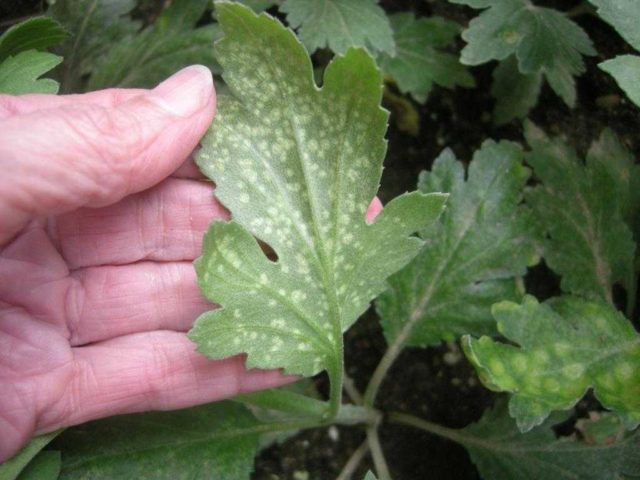
Mosaic stains chrysanthemum leaves and cannot be treated
It is impossible to cure mosaic disease. Affected chrysanthemums must simply be removed from the site so that the disease does not spread to neighboring plants.
Chrysanthemum pests and control
In addition to diseases, garden pests threaten chrysanthemums. There are several insects that are especially dangerous for flowers.
Leaf nematode
The most dangerous pest of chrysanthemums are nematodes - small round worms that are difficult to see with the naked eye. They hibernate in the soil or in uncleared plant debris, and with the onset of heat they move to the stems and leaf plates.
You can recognize the nematode by its characteristic symptoms - yellow-brown spots on the leaves, spreading from bottom to top. The spots gradually cover all the green leaf plates of the plant, merge with each other, the affected leaves curl and fall off.
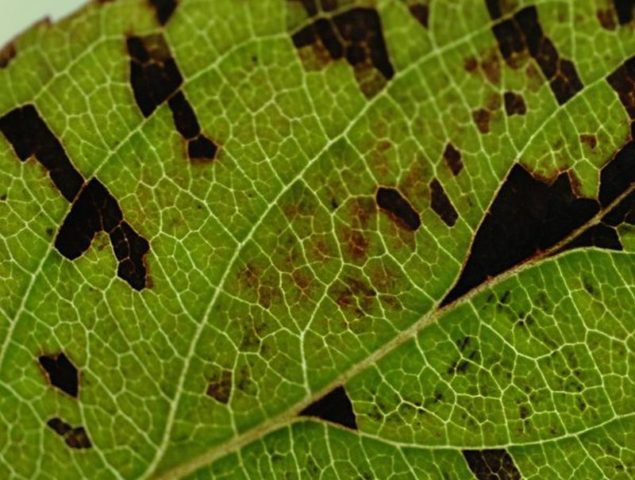
When infected with a nematode, dark spots appear on the leaves.
Nematoda is a pest, when it appears, plant material must simply be destroyed. The infected chrysanthemum is removed from the flower bed along with the adjacent soil, the soil is carefully treated with insecticides, for example, Aktara.
Aphid
Aphids are a very common pest of flowering perennials. It is quite difficult to notice it from afar, but if you look at the leaves closer, then small green or reddish insects will become noticeable on the back surface of the leaves.
Aphids feed on sap of chrysanthemum leaves and shoots. If you do not fight the insect, then in just one summer, the aphid will be able to destroy all flowering perennials. The pest is not only very voracious, but also lays eggs several times per season.
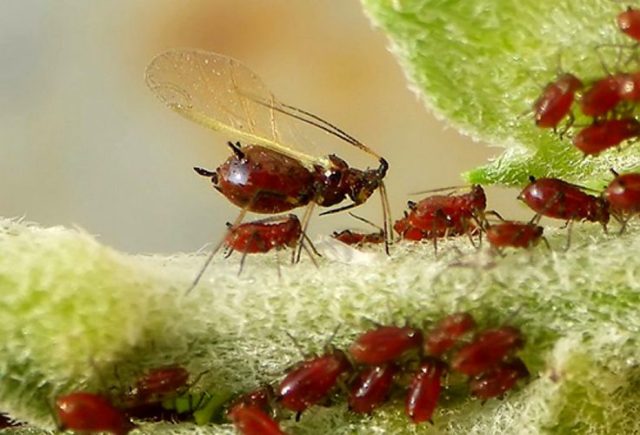
Aphids can almost completely eat chrysanthemum bushes
It is necessary to fight aphids by spraying. If the chrysanthemums are not severely affected, then a soap or onion solution will be enough. With abundant infection, it is better to use insecticidal chemicals - Aktellik, Aktara.
Spider mite
Chrysanthemum plantings are harmed by spider mites. They usually appear in early spring and closer to autumn, it is difficult to notice them at the very beginning. But over time, symptoms become noticeable - the foliage that the tick feeds on begins to turn brown and dries up, and a slight cobweb bloom appears on the back of the leaves.
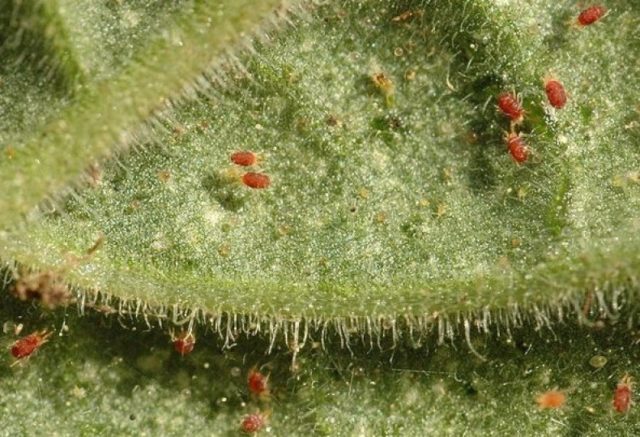
When a spider mite appears, the leaves below are covered with a thin cobweb
The fight against spider mites is reduced to spraying flower beds with insecticidal preparations or colloidal sulfur. Sanitary cleaning is important - the spider mite hibernates in plant debris and lumps of soil. In order to prevent it from multiplying, it is imperative to clean up the site and loosen the soil with the onset of autumn.
Meadow bug
The harmful insect damages all the green parts of the chrysanthemum. The bug feeds on leaves, buds and blossoming flowers. Under the influence of the pest, the plant stops blooming, its buds and flowers crumble, and the leaves are deformed.
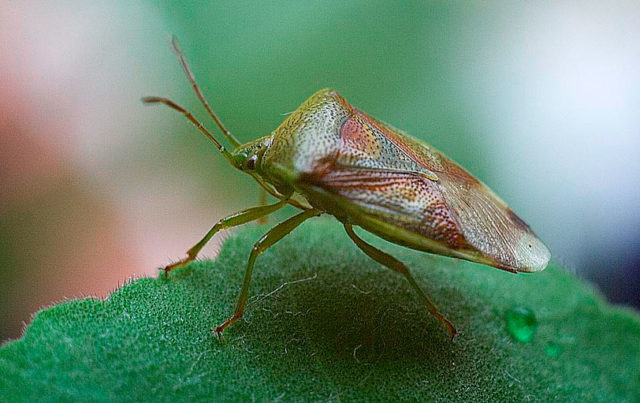
Meadow bug damages buds, leaves and stems
The fight against the meadow bug consists in spraying the flower beds with insecticides - Aktellik and Aktara, Skor. For weak infections, you can use homemade solutions - soap and onion, but they do not always bring results.
Prevention of diseases and pests in chrysanthemums
Many diseases are treatable, but the easiest way is to prevent their occurrence, and not to waste energy on the fight against ailments. Disease prevention in chrysanthemums comes down to several measures:
- Every fall, the flower beds are carefully cleaned and all plant debris removed. In clean areas, fungi and pests appear much less often.
- Flowering perennials should be watered sparingly, avoiding waterlogging of the soil. Fungal diseases are much more likely to develop in swampy ground.
- The soil in a flower bed should be regularly fertilized with potassium and phosphorus - these substances increase the resistance of plantings to diseases.
- Every spring, the plants must be prophylactically sprayed with Bordeaux liquid, three times after the start of the growing season, at intervals of 10 days.
So that diseases and pests do not develop on a flower bed with perennials, it is recommended to regularly loosen and weed the soil.
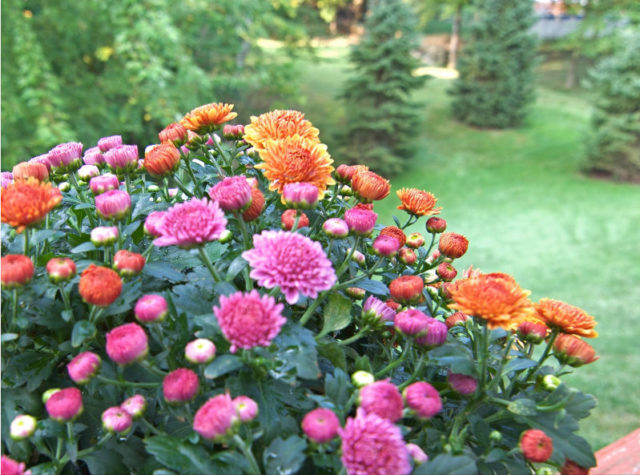
For the prevention of diseases, it is important to maintain the site in a neat condition.
Conclusion
Chrysanthemum diseases are easily recognized by their characteristic symptoms. With the timely start of treatment, most ailments can be dealt with. If any diseases are incurable, infected chrysanthemums should be removed as soon as possible.

